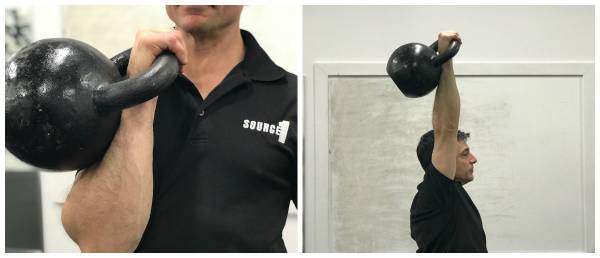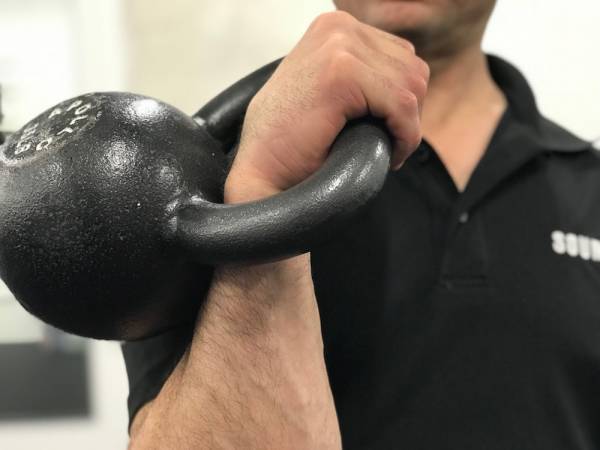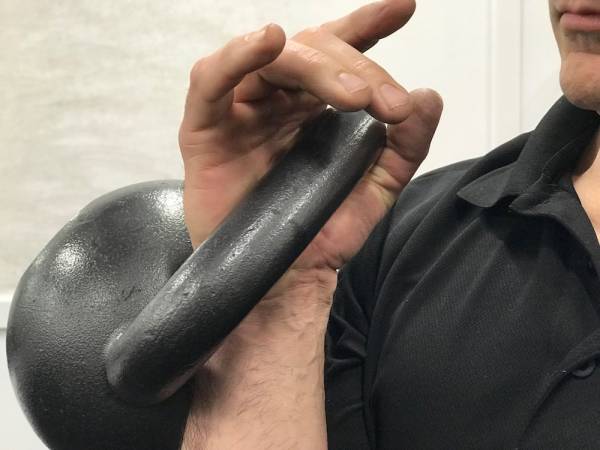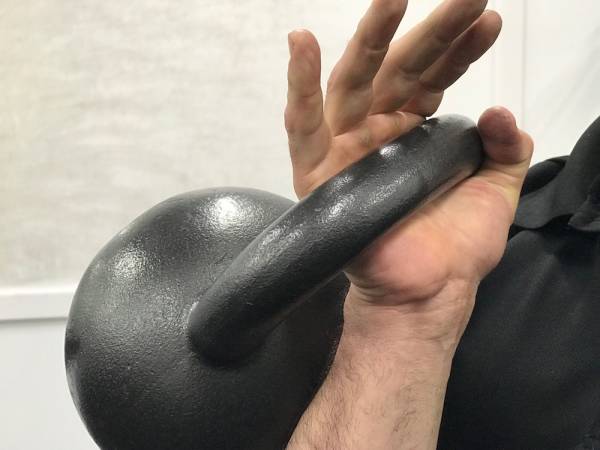Let me confess right off the bat that I enjoy pressing tremendously. Single bells, double bells, I love them both! If I could meet all my goals by working on only one lift, it would more than likely be the kettlebell press. I enjoy coaching the push press and jerk, but there is just something utterly primal and enjoyable about strict pressing a big bell over your head. (And by “big” I mean half your body weight or more.)
Let me confess right off the bat that I enjoy pressing tremendously. Single bells, double bells, I love them both! If I could meet all my goals by working on only one lift, it would more than likely be the kettlebell press. I enjoy coaching the push press and jerk, but there is just something utterly primal and enjoyable about strict pressing a big bell over your head. (And by “big” I mean half your body weight or more.)
As with any true joy in life, some work must be done beforehand. The joy of pressing heavy can only be attained by learning how to press properly and repetition of correct technique. There are a number of details that go into the proper technique for the press which we will dive into at a later date, but for this article we will focus on the most common mistake I see people make when they press: improper wrist alignment.
Why Wrist Alignment Is Important
Most people who are new to kettlebell training, or who come to it with a barbell or dumbbell background, support the weight of the bell on their palm, as below.
This is a natural instinct given their previous training, but it causes the wrist to extend so the palm faces upward and the back of their hand moves closer to their forearm. This change places the bell in a mechanically disadvantageous position making it harder to support. More on this detail in a moment, for now I will admit this is not a deal breaker, at least when pressing not-so-heavy. Technical errors can be pushed past when the weight is not challenging. But hopefully your goal is to press a “big” bell, as defined earlier, and to do so, you must press well. Pressing well requires you to support the load with your skeletal system and if you keep your wrist in straight alignment with your forearm, that mission will be accomplished.
The principle difference between a kettlebell and a barbell or dumbbell is clearly its offset handle design. When pressing a barbell or dumbbell the lifter grabs the center of mass so the wrist must extend a small amount when putting either of these tools overhead or the load will not be sufficiently supported. This is not the case with the kettlebell. The offset handle of the kettlebell, in fact, does not allow the lifter to control the center of mass so the lifter is always forced to move a bell from a disadvantageous position making it pound for pound more challenging to stabilize than a bar or dumbbell. Also, with the bell we are literally putting our hand through the weight which allows and requires us to modify the wrist position.
Keep a Neutral Wrist
There’s a saying in martial arts that there are “no wrists” in punching. This means you want to keep your wrist neutral when striking with the fist, maintaining a straight line from your knuckles to your elbow and/or shoulder (depending on the punch) in order to deliver maximum force upon impact. Flexing or extending the wrist will minimize power and potentially cause some self-inflicted and easily avoidable injury—this saying also applies to kettlebells. Bending the wrist out of alignment with the forearm will move an already hard to stabilize weight further off-line making it even harder to control and taking energy that we could otherwise use to press the bell. In short, we must have a straight wrist when we press the kettlebell, as below.

We can cheat through bad form with a light bell, but remember that “practice does not make perfect, practice makes habit.” Why build a bad habit on your lighter reps when you can continue to learn proper technique? (That’s a rhetorical question. There’s no good reason, so don’t do it.)
So how does one accomplish this preferred, efficient neutral wrist position? There are a couple of tactics you can employ to dial in the proper wrist alignment for pressing the kettlebell. The first is simply to not allow the bell to extend your wrist, pulling your palm to the sky. Simply crank down on the handle of the bell (like throttling down on a motorcycle) so you feel like you’re pulling your palm toward the inside of your forearm. Below is an exaggerated example so you can see what I mean. As the bell gets heavier and heavier, this action will probably not be visible, but the effort and effect will still be there.

Another choice is to shove your hand deep into the handle of the bell and angle the handle diagonally across your palm from just above your thumb to the outer corner of your hand.

This angle will reduce the amount of pressure pulling your palm to the sky. If you grab the bell and allow the handle to run side to side, across your palm just under your fingers, (as in the example below) you will be in a dramatically more disadvantageous position to support the weight.

Get in there deep instead and you will feel much less pull on the palm. Go ahead and try both versions now with your max press weight bell (or heavier) and feel the difference.
Put It All Together
These two things done in concert will allow you to get the optimal wrist angle for pressing the kettlebell. Try them both in your next training session and feel the difference. And finally, remember that pressing well and heavy brings joy to your life, so do these things purely in the pursuit of happiness. You’ll be glad you did. Now get to pressing!






